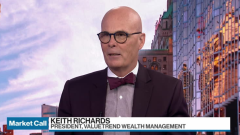Oct 11, 2023
Treasuries, Bunds Rally on Fears of Rising Middle East Tension
, Bloomberg News

(Bloomberg) -- Treasuries delivered mixed results Wednesday, with long-dated tenors holding most of an advance driven by haven demand while hotter-than-expected US wholesale inflation data pushed short-term yields higher.
The gains were pared in US trading after an auction of 10-year notes produced weak demand metrics on the heels of the rally that had trimmed its anticipated yield by as much as 11 basis points. Haven demand lowered 10-year yields in most other developed bond markets as well.
Treasury yields climbed to fresh multiyear highs last week after strong labor-market data reinforced expectations that the Federal Reserve will keep its policy rate elevated while inflation remains above its 2% target. Wednesday’s bigger-than-anticipated increase in producer prices bolstered that view, though consumer-price data due Thursday has more power to sway Fed policymakers contemplating another rate increase this year.
The two-year Treasury note’s yield rebounded after September producer prices rose 0.5%, causing the annual rate to accelerate for a third straight month to 2.2%. It extended its climb after the auction, topping 5.02%.
Yields across the Treasury curve reached session lows before the US trading day began after reports that two missiles were fired from Lebanon toward Israel, which also intensified air strikes on Hamas targets in Gaza. Israeli leaders formed an emergency national government to coordinate the country’s response following the deadly weekend attacks.
Read Israel Latest: Netanyahu Talks to Biden, ‘False Alarm’ in North
The Israel-Hamas conflict “increases volatility and uncertainty. Within this scenario the only thing is to keep risk at minimum,” said Althea Spinozzi, senior fixed-income strategist at Saxo Bank A/S. “As things can change quickly on the conflict front, we cannot but remain defensive.”
Earlier this week, Fed officials expressed the idea that the recent surge in US yields may have done some of the job of tightening financial conditions for them, lifting Treasuries. Fed Governor Michelle Bowman said Wednesday interest rates may need to rise further and stay higher for longer than previously expected to get inflation down to the central bank’s goal.
Comments from Fed officials are “a sigh of relief for markets, given everything is so much dependent on where this terminal rates argument goes,” Ella Hoxha, head of fixed income at Newton Investment Management, told Bloomberg TV.
The moves may have been compounded by the view that yields went too high. Theophile Legrand, a rates strategist at Natixis SA, said this does not appear to be a classic risk-off configuration, given swap spreads — a measure of risk — are tighter and European equity markets are relatively stable.
“It’s hard to see what the trend will be,” he said, surmising the moves are a reversal of the recent rise in yields led by the longer end of the curve.
Money markets price less than a 40% chance of another quarter-point hike from the Fed this year. Those odds were unchanged after the US central bank released the minutes of their September meeting.
Fed officials agreed that policy should remain restrictive for some time to keep cooling down inflation, while noting risks had become more balanced, adding: “All participants” agreed that the committee was in a position to “proceed carefully” and that policy decisions would be data-dependent and take into account “the balance of risks.”
Treasury yields had a muted reaction to the release of the minutes, and the curve broadly remained flatter on the day. The difference between five-year and 30-year Treasury yields flattened 8.6 basis points, the largest such move since late-March, while the spread between the shorter-duration two-year and 10-year maturities also flattened the most in nearly seven months.
--With assistance from Dayana Mustak, Guy Collins, Michael Mackenzie, Carter Johnson and Cristin Flanagan.
(Adds auction results, updates yield levels.)
©2023 Bloomberg L.P.






